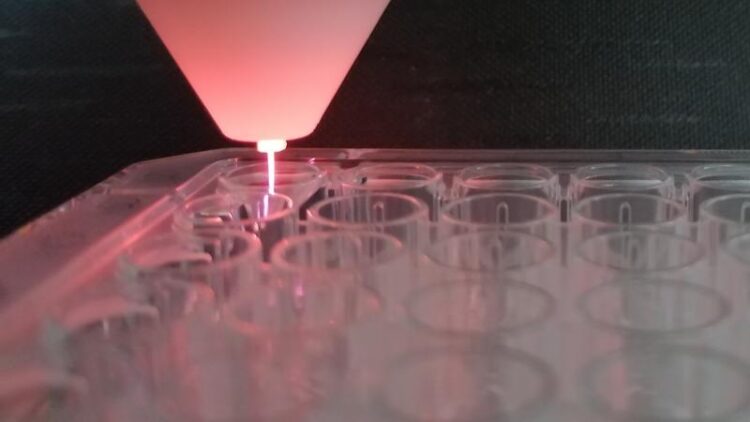Cold physical plasma kills corona viruses

Prototype of the newly developed INP plasma jet for combating viruses
(c) INP
A Greifswald research team from the Centre of Excellence ZIK plasmatis at the Leibniz Institute for Plasma Science and Technology e.V. (INP) was able to demonstrate for the first time in laboratory experiments the inactivation of corona viruses by physical plasma. The new method promises innovative therapies for the corona pandemic and other infectious diseases.
Physical plasma, the so-called fourth state of matter, has been finding its way into medicine for several years. Clinical successes are increasingly being recorded, particularly in the healing of chronic wounds. The effectiveness is based, among other things, on the ability of cold physical plasma to effectively kill pathogens and thus fight wound infection.
Prevention and control of infections have become more important as a result of the Covid 19 pandemic. More than ever, new measures and approaches are needed to protect people and health systems from the consequences of the pandemic. Cold physical plasma can also play a role here. The effectiveness of plasma against a wide range of microorganisms, including multi-resistant pathogens, has been demonstrated many times. In contrast, there are comparatively few studies on the effectiveness against viruses.
In Greifswald, it has now been shown that the ability of viruses to penetrate cells is significantly reduced after contact with a newly developed plasma jet. In the specific experiment, hepatitis viruses from mice (MHV-A59-eGFP), which belong to the group of corona viruses, were treated. The effect is due to free radicals that are formed in the plasma.
Prof. Dr. Thomas von Woedtke, head of plasma medicine at INP, comments: “Our goal is a plasma device that can be used to combat viruses such as SARS-CoV-2 directly on the oral mucosa. The laboratory results are an important step in this direction. We were able to identify the mechanism of inactivation of the viruses. From this, a variety of new, innovative approaches for the therapy and prevention of pandemics and infections in general can be derived.”
The study, currently published in the journal Free Radical in Biology & Medicine, was conducted as part of the project “PlasmaplusCorona – Plasma-based disinfection of the respiratory tract to reduce the SARS-CoV-2 viral load in vitro and in vivo”, funded by the German Federal Ministry of Education and Research (BMBF) since 2021, in which a research network with the Leibniz Institute of Virology (LIV, Hamburg) and the Leibniz Lung Centre (FZB, Borstel) under the leadership of the Leibniz Institute for Plasma Science and Technology e. V. (INP) is researching a technical solution for the local treatment of the virus-infected respiratory tract.
Originalpublikation:
Original article:
D.M. Mrochen, L. Miebach, H. Skowski, R. Bansemer, C.A. Drechsler, M. Hein, U. Mamat, T. Gerling, U. Schaible, T. von Woedtke, S. Bekeschus. Toxicity and virucidal activity of a neon-driven micro plasma jet on eukaryotic cells and a coronavirus. Free Radical Biology and Medicine (2022), doi: https://doi.org/10.1016/j.freeradbiomed.2022.08.026
Weitere Informationen:
Media Contact
All latest news from the category: Medical Engineering
The development of medical equipment, products and technical procedures is characterized by high research and development costs in a variety of fields related to the study of human medicine.
innovations-report provides informative and stimulating reports and articles on topics ranging from imaging processes, cell and tissue techniques, optical techniques, implants, orthopedic aids, clinical and medical office equipment, dialysis systems and x-ray/radiation monitoring devices to endoscopy, ultrasound, surgical techniques, and dental materials.
Newest articles

Properties of new materials for microchips
… can now be measured well. Reseachers of Delft University of Technology demonstrated measuring performance properties of ultrathin silicon membranes. Making ever smaller and more powerful chips requires new ultrathin…

Floating solar’s potential
… to support sustainable development by addressing climate, water, and energy goals holistically. A new study published this week in Nature Energy raises the potential for floating solar photovoltaics (FPV)…

Skyrmions move at record speeds
… a step towards the computing of the future. An international research team led by scientists from the CNRS1 has discovered that the magnetic nanobubbles2 known as skyrmions can be…





















